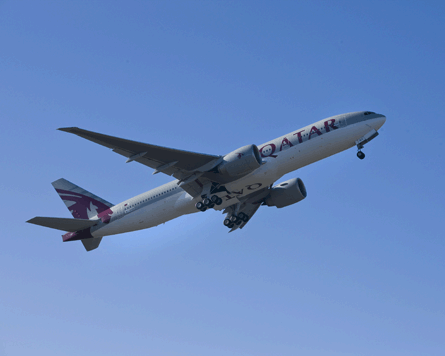Unlike their single-aisle product line-ups, Airbus and Boeing's widebody families have never been perfectly aligned in terms of size and performance.
The European airframer's A330 twinjet spans two of its rival's family - the top end of the 767 and the bottom end of the 777 - and is directly in the sights of Boeing's 767 replacement, the 787. And while the current versions of the A340, the -500/600, are more in syncwith their US rivals - the 777-200LR/300ER respectively - the Airbus quadjet appears to be in the twilight of its life after several successive years of slow sales and low output.
Despite Airbus's success in racking up launch deals for the A330/A340's ultimate replacement, the A350 XWB, sales of the current twinjet have been at record levels, with 196 aircraft sold in 2007 and a further 142 in 2008.
 |
|---|
© BoeingThe GE90-115 powered 777 versions now account for all orders and most deliveries |
The same has not been true for the A340. Production has effectively ended for the original CFM56-powered A340-300 variant - the last of 246 on order was delivered in 2008 - while output of the R-R Trent 500-powered -500/600 is at a trickle.
Similarly, at Boeing's 777 plant in Everett, the output centre of gravity has shifted firmly in favour of the newer GE90-115-powered -200LR/300ER variants.
With a backlog of more than 300 aircraft and production running at seven a month the airframer's biggest twinjet is set fair for the near term. The collapse in the cargo market was largely behind the decision to cut 777 output by two units a month to five from June 2010.
But with the A350 looming, Boeing is evaluating how it could develop the 777 to counter the new threat. Various alternative mid-life updates are being examined along with a broader response such as a 787-based development and an all-new 777 replacement.
Meanwhile, Airbus has been working to close the gap to the 787 with the A330. A 5t increase in maximum take-off weight to 238t will be available on new-build A330-200s from September 2010 providing a 610km (330nm) increase in range or an extra 3.4t of payload.
 |
|---|
© Airbus |
The upgrade can also be retrofitted to A330-200s built from February 2004. Korean Air was the first airline to commit to the higher-weight version with an order for six earlier this year.
In an effort to help sales - and current operators - of the A340, Airbus has developed a lower-drag belly fairing, which the airframer believes is worth around 1% in terms of fuel-burn reduction. It will be standard on new-build aircraft from the end of this year, with a retrofit also available.
The four-engined jet has also benefited from an increase in maintenance check intervals that Airbus has negotiated with regulatory authorities for it and its twin-engined sister, which Airbus claims should reduce airframe direct maintenance cost by up to 6%.
In the meantime, the two airframers have been developing all-cargo variants, which are entering the market during the worst downturn the freight industry has experienced in its modern history. The 103t payload 777F - developed from the -200LR platform - made its debut in February with Air France. However, the downturn has resulted in 787Fs for another launch customer - China Southern Airlines - being deferred, withthe result that brand-new airframes have been parked in the desert.
Airbus will be hoping that the timing will be better for its new A330-200F. This 64t payload freighter is due to fly during November and enter service with Etihad Airways' cargo arm in mid-2010.
Despite the sector's current poor trading conditions - cargo traffic has seen year-on-year declines of over 20% - the airframers are evaluating cargo conversion opportunities for the in-service fleet of A330s and 777s, and Airbus and Boeing could both launch modification programmes within the next 12 months for the A330-300 and 777-200/200ER, respectively.
SALES SUFFER
Sales of all the in-production twin-aisle aircraft have suffered in 2009, with orders down substantially on last year. The A330 and 777 are neck and neck at the end of the third quarter, on 18 and 16 net orders, respectively. The A340 and 767 are both in deficit to the tune of one and three aircraft, respectively.
Boeing leads the way in widebody output, delivering 63 777s and six 767s in the first nine months. The A330 is not far behind the big Boeing, on 53, but A340 output remains low, with just nine shipments.
The A330 boasts the largest backlog, with 390 on order, compared with 303 for the 777 and 57 for the 767. With just 14 A340s still to be delivered, production could run out by the end of next year unless more sales are secured.
With the passenger version of the 767 having seen a recovery in sales in the wake of the 787 delays, half of the 10 deliveries in the first nine months were the -300ER model. Freighter production accounted for four aircraft during the period, including the first -300Fs for DHL - which were equipped with Aviation Partners Boeing winglets.
Source: Flight International



















